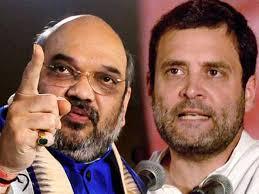New Norms In Electioneering?

Mahesh Vijapurkar
The Election Commission has embarrassed itself by first not issuing notices to the BJP Chief, Amit Shah. Then, again, by issuing a notice to Rahul Gandhi for breach of a similar code of conduct – reaching out to the voters after the 48-hour ‘no-campaign’ rule came into play and withdrawing it. By deciding now to consider changes, if any were possible, to contend with the impact of modern day media on breach of the code, it has woken up to a long overdue need.
Information, visual, audio, and written, is carried to the population in real time because of the technological revolution (which is still unfolding and who knows with what impact!). The adverse Impact was visible much earlier, and the EC ought to have realised that its model code of conduct about the interaction between the parties and candidates on one side, and the voters on the other, needed a serious re-look.
The 48-hour period of silence is meant to insulate the voter from the cacophony of the election campaign to enable a considered choice by the voter by evaluating the claims and counterclaims, the promises and accusations that fly for weeks and days prior to polling. Our elections are perhaps the noisiest, and now from the streets, the din penetrates the drawing room because of the TV. And by Internet on the smart phone.
But what rankles is that all along, Election Commission has allowed political parties to carry front page advertisements on the day of the voting touting their merit for being the next ruler of a state or a country. That is also a violation of the spirit of the model code of conduct, if not the Act, but it did not get the attention it deserved. All parties benefitted, at least those who booked the space earlier, and media financially benefitted, so a conspiracy of silence prevailed.
Let us go back to Narendra Modi who showed the party symbol after casting his vote in the 2014 Lok Sabha polls, standing so close to the polling station. It was a violation of the code, but given the speed and reach of the media now, the visual could have come from another spot, from a region where the campaign for the second phase was going on. Thus, the rules in place are easily defeated. Likewise, if Modi had done a roadshow elsewhere in or outside Gujarat.
The committee set up on Sunday night by the EC with representatives of the ministries of Information and Broadcasting Ministry, Law, the, National Broadcasters Association, and Press Council of India to re-examine the scope of Section 126 of the Representation of People Act is welcome. But its task, let me caution now itself, would be difficult. Overcoming the “prevailing context of communication technologies” is likely to be tougher than establishing the credibility of the EVMs.
Unless, of course, it is decided that there shall be no more polling in phases. Phase-wise polling allows for information flow across the divisions the EC creates to conduct the polls for logistic reasons. Reasons like managing law and order, movement of law enforcing personnel, etc. in what is indeed an increasingly acrimonious electioneering culture in the country. It has not even occurred to the EC that the studio debates even as the polling goes on could be influencing choices of the voters.
It would be impossible to deny access to campaign activity being conducted in one place to the area which would be polling. It cannot be that telecasts can be partially blocked to one region while it is expected to benefit voters who are yet to go to polls. It is not so simple as proscribing the release of the findings of exit polls till the last poll has been cast. Re-polling in a few booths in Gujarat due to “technical reasons” on Sunday after the exit polls were released could have influenced the voting preferences.





